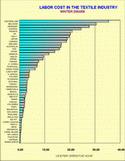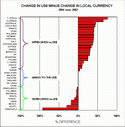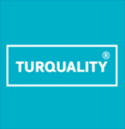New Twist, Newsletter Volume 1,
March 08, 2006
MESSAGE FROM THE
PRESIDENT
OF WERNER INTERNATIONAL
In the past, Werner
International prepared a newsletter
called “New Twist” which was
distributed to numerous companies
and clients and was published over
quite a number of years. It covered
key topics in the textile and
clothing industry and was an
important reference point for
company senior managers and for
institutions worldwide.
After a few years of “silence”, we
are pleased to announce that New
Twist is back, with a fresh format
and in a lively and readable style,
and that we will be sending it to
you directly by e-mail.
New Twist is not simply a source of
information about the industry, but
also gives brief and regular updates
on Werner activities and services.
In the first issue, for example, we
publish the latest edition of the
Labour Cost Comparison data – an
essential source of comparison
between all the key textile
producing countries – along with
detail of various projects in
Turkey, India and China.
We sincerely hope you will enjoy it.
Constantine Raptis
GENERAL OBSERVATIONS
The global
competitive landscape is undergoing
a major shift because of the
introduction of A new series of
international trade agreements.
These trade agreements are already
heavily affecting the global
structure and distribution of the
textile and clothing industries but
their impact will become even more
important with the full
implementation of the WTO-agreements
on textiles & clothing and the
introduction of even more regional
trade agreements. The global textile
& clothing industry is currently
experiencing a major shift in
business patterns. The most evident
elements of this are:
-
The rapid pace
of transformation that is
affecting North-American and
European based industry through
relocation and product
repositioning.
-
Shifting global and
regional sourcing patterns for
supply of textiles & clothing
-
The rapid evolution
of the apparel retail business,
characterized by a concentration of
large retailers and fast growing
retail chains.
-
The effective removal of
all textile trade barriers both in North
America and Europe
-
Increasing fragmentation
of the consumer base.
-
Quickly evolving consumption
patterns.
-
The increasing access to, and use of,
Internet technologies, which call for a technology
driven, re-design of traditional business models.
A new business era is therefore in front
of us. An era for which textile and clothing companies must
prepare themselves with a strategic effort in order to
adapt, improve and redesign their business models to sustain
growth, defend and improve market position and enhance
profitability.
All the core activities of a textile or apparel company,
ranging from the best utilization of its tangible assets to
the development and deployment of intangible assets will
have to be re-evaluated and aligned in a single, coherent,
often revolutionary, winning strategic formula or better,
portfolio of winning formulae.
Critically, winning business models must be developed in
order to enhance coherence between market vision, short term
tactics, production and sourcing (manufacturing strategy),
sales and marketing (marketing strategy), IT, accounting and
human resources. Now, more then ever, all areas of business
must work in harmony to enact a unique and winning business
vision for the future success of textile & clothing
companies.
However, fundamentally all successful strategies are
predicated on cost leadership. Cost advantages can be
achieved in manufacturing as well as through effective
sourcing and taking advantage of foreign investments. And it
is within this perspective that the results of the new
international labor cost comparison in the textile industry
have to be seen.
The Winter 204/2005 hourly labor cost comparison in the
primary textile industry covers 49 countries. It includes
all the main textile producing countries of the world. The
folllowing graph gives in summary form the total hourly
labor cost in U.S. dollars (including social charges) for
every country in the Winter of 2004/2005 (based on
prevailing exchange rates on November 20th 2004).

click to view
HIGHLIGHTS
Switzerland is still in first
place with the highest hourly labor cost in the textile
industry, a position it has held almost continuously since
1987.
Amongst the top ten, European Union countries take
seven positions, with only Spain, Greece and Portugal having
a somewhat lower hourly cost.
Japan has dropped from the first place in 2000 to the
third place in 2004.
Several of the positions have changed, most of this is due
to changes in the exchange rate to the United States Dollar.
The USA itself is occupying the 12th place. While in
2000 the USA still ranked higher than Italy, France and the
UK, now with the strong Euro, this picture has changed.
There is not much movement in the lower part of the ranking:
the lowest labor costs are noted in Asia, with
Bangladesh, Vietnam, Pakistan, Sri Lanka, ...
Taiwan, Hong Kong, South-Korea have about similar
labor cost levels as those of Portugal.
Within Eastern Europe, overall labor cost has been
catching up fast, with countries like Poland and the Czech
Republic reaching hourly rates of close to 4 US Dollars.
Textile workers in Bulgaria and Romania on the other hand
only cost about as much as workers in Mauritius or Thailand.
Latin American countries remain very competitive with
labor costs between 2 and 3 US$, the same level as
Turkey, Morocco and Tunisia.
The wage gap between developed and developing countries is
increasing and the range from the lowest hourly cost to the
highest hourly cost is showing an ever increasing expansion
:
-
in 1989 2% to 150%
-
in 1998 2% to 186%
-
in 2004 2% to 224%.
It should also be noted that in some countries there is a
substantial difference in hourly labor cost from company to company, from region
to region, from spinning to finishing, from large to smaller company, etc.
As in the past, the variation in exchange rate of U.S.dollar is having a bigger
impact in many cases than the actual increases in local currency. To illustrate
this, we have deducted the increase in labor cost in local currency from the
increase in labor cost in US$ terms. It becomes evident that a different
currency policy is resulting in substantial shifts in labor cost over a short
period of time.

click to view
As in previous years, we would like to stress that the hourly labor cost is but
one of the many factors which impact the competitiveness of the textile
industry. A factor for labor productivity has to be introduced in each case to
arrive at a more meaningful unit labor cost. But even then, it can only give a
limited view of the total competitiveness of the primary textile industry since
total competitiveness depends on other cost and non cost factors, such as raw
material, energy, interest cost, inventory turn-over, throughput time, quality,
styling, etc., etc.
If
you would like to receive a full
copy of the new Wage Report, please
click here and
request your
full LCC report by email.
We will e-mail you the Wage Report
within 24 hours.
If
you would like to contribute to the
Wage Survey, please
submit the LCC
survey form. It will help
us to have these facts upfront to
better serve. All of the fields are
not required, but the more
information we have the easier it is
to route this email to the right
department.
If
you would like to contact us, please
go to the "Contact
form on our website -
www.wernertex.com"
The average
labor costs shown in this report,
might not always check with the
official statistics of the
respective countries for the textile
industry. They are based on data
collected and made available to
Werner International and are a
realistic representation of the
actual labor costs. This service
Werner International provides to its
clients since 1968 and is based on
data supplied by a panel of Werner
clients in each of the participating
countries.
Copyright © 2005
 The post-quota
scenario raises endless questions
and uncertainties over the future of
the global textile and apparel
industry. The post-quota
scenario raises endless questions
and uncertainties over the future of
the global textile and apparel
industry.
Everybody is in agreement with the
anticipation that China will
continue to strengthen its position
and continue to expand its share of
global textile and apparel trade.
However, the key questions are
concerning the size and pace of such
expansion such as; which markets and
product segments will be most
affected and, most importantly, what
strategies are left for countries
and companies throughout the world
positioned on the “China path of
growth?”
The impressive capacity build-up of
many Chinese enterprises, most of
the time un-matched by a clear
strategic vision, is rapidly
deteriorating market prices and
transforming new product categories
into commodities.
The limited visibility and
understanding about the Chinese
firms bottom line thinking makes it
even more difficult to predict their
sensitivity to classic business
behavior.
For many textile and apparel
companies throughout the world there
is only way to react to such an
unprecedented disruptive ‘new
entry,” and that is to “get in the
game.” It is vital to learn as much
as possible about the Chinese way in
order to transform the threats into
opportunities.
With the announced extension of WFOE
range of activities to trade (under
WTO ruling, fully foreign owned
companies will be soon allowed to
carry out trading domestic
activities), a new range of options
will be available for apparel and
textile companies interested in
playing domestic in China.
Werner International has been
directly present in China since 2002
and has been very active in
providing assistance to foreign
textile and apparel companies in
their effort to understand this
market. Werner has assisted these
companies with developing their own
approach, in several cases involving
the set-up of a manufacturing
operation.
Despite the fact that Chinese
companies may enjoy “peculiar
business rules” a number of weakness
areas are present and tend to limit
their ability to move up-market on
the higher value segments.
Quality, own product development
associated to a finely tuned
industrial optimization formula,
flexibility, long-term views on the
market evolution are all relevant
example of such limits.
As difficult as it is to win over in
a cost-of-factors perspective,
Chinese competition calls
international players to find
strategic approaches, which can
leverage on their management skills
and the ability to create value. No
doubt a challenge, but as many
repeat, no one can afford not to
have a Chinese strategy.
TURKEY
 Turquality:
A branding program to “qualify” and
promote Turkish excellence in
Apparel production & marketing Turquality:
A branding program to “qualify” and
promote Turkish excellence in
Apparel production & marketing
At the end of
2004 Werner International was
appointed as the sole management
consultancy company in charge of
providing strategic guidance for the
set-up of the Turquality branding
program.
This ambitious project, which is
promoted by the Turkish Ministry of
Trade and Industry, aims to upgrade
the international image of
Turkish-made products. It also
strives to provide the industry with
a strong stimulus to upgrade and
re-position on the higher segments
of the now global market.
In conjunction with ITKIB, the
Istanbul Association of Textile and
Apparel Exporters, the apparel
industry has been selected as the
“pilot” industry to develop the
program and its procedures, then
transferring them to other
industries later this year.
Werner International was appointed
as the mastermind of the industrial
part of the program, thanks to both
vast and international experience.
The Turquality program mainly
consists of two complementing
activities.
On one side, there is the
development of a “quality manual and
accreditation scheme” which defines
the quality standards which
applicants will be required to meet
in order to be accepted in the
program and for use of the
Turquality logo and brand.
On the other side, an articulated
auditing program is currently being
implemented with the aim to
“benchmark” Turkish companies with
international best practices -
building on Werner’s wide experience
in this field all over the world.
This part of the project is
particularly focused on each
company’s organization and
processes. The purpose is to provide
each participating company with a
dynamic tool to identify its
weakness areas in the path towards
excellence. This will be done
according to each individual
companies’ own, specific strategies.
Therefore, Turquality will be much
more then a branding program. It
will also become a very versatile
platform for member companies to be
supported while they strive towards
excellence and to successfully
compete with today’s highly dynamic
international markets.
Werner International is particularly
proud to be contributing to such an
interesting project, which is such a
complex mix of marketing, quality
upgrading and strategic positioning,
to be implemented for the first time
in Turkey and, possibly, in the
world.
CHINA
Werner Quality Control system
adopted in China
After a successful implementation of
the Werner Quality Control System at
their Jinhua plant in Sichuan, the
China Resources Light Industries and
Textiles (Holding) Co. Ltd decided
to introduce the modern approach to
six of their companies located in
the provinces of Jinan and Shandong.
The Werner testing plan, standard
and tolerances and quality
management were introduced in 10
plants. All these units, except one,
are equipped with Uster Evenness
tester 3 and 4 and are now ready to
fulfill the quality requirements of
the local and export markets.

INDIA
Investments in India
 Indian companies did not lose time
to react to the elimination of
quotas. Major investments were done
to increase the capacity with the
clear objective to serve the
American market. Indian companies did not lose time
to react to the elimination of
quotas. Major investments were done
to increase the capacity with the
clear objective to serve the
American market.
Werner is directly involved in the
start-up of the Welspun India Ltd
integrated manufacturing complex
near Bhuj, northwest of Mumbai. The
Welspun complex will be dedicated to
the production of terry towels and
bed sheeting fabrics and contains
all the processes from spinning to
the ready-made products. The terry
towel dyeing and finishing plant is
particularly interesting with a
continuous preparation, dyeing and
finishing range.
Werner International has been
awarded the mandate to train all the
production and supervision
personnel. The Werner general
management systems related to
quality control, preventive
maintenance and raw material
management will be implemented in
addition to specifically designed
organization systems for each
section.
MEXICO
Seminar for the SME Mexican Spinning
Companies
 Canaintex, the
Mexican national chamber for the
textile industry for the small and
medium textile enterprise, organized
a 5-day seminar. Senior
representatives of 16 companies,
many of them major players in the
industry, participated in this 5-day
exchange. Canaintex, the
Mexican national chamber for the
textile industry for the small and
medium textile enterprise, organized
a 5-day seminar. Senior
representatives of 16 companies,
many of them major players in the
industry, participated in this 5-day
exchange.
Mr. Alain Mathieu, of Werner
International, lead the seminar with
sessions dedicated to the optimum
organization of a modern spinning
mill, raw material management,
preventive maintenance, human
resources development and quality
control.
“The interest, participation and the
level of management were
outstanding. The subject of
training, in particular, really hit
a sensitive cord so we dedicated an
entire day to discuss the problems
and the possible solutions,”
mentioned Mr. Mathieu. The Werner
AMPS© training system was in fact
fully disclosed to the participants
who were keen to note the simple,
efficient and economic approach to
the personnel selection and
training.
More seminars will take place in
Mexico City with Werner
International experts in weaving,
knitting and finishing.
Visit our
website at www.wernertex.com
|

